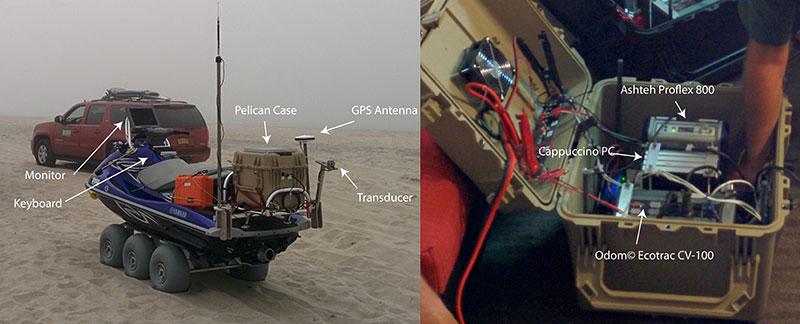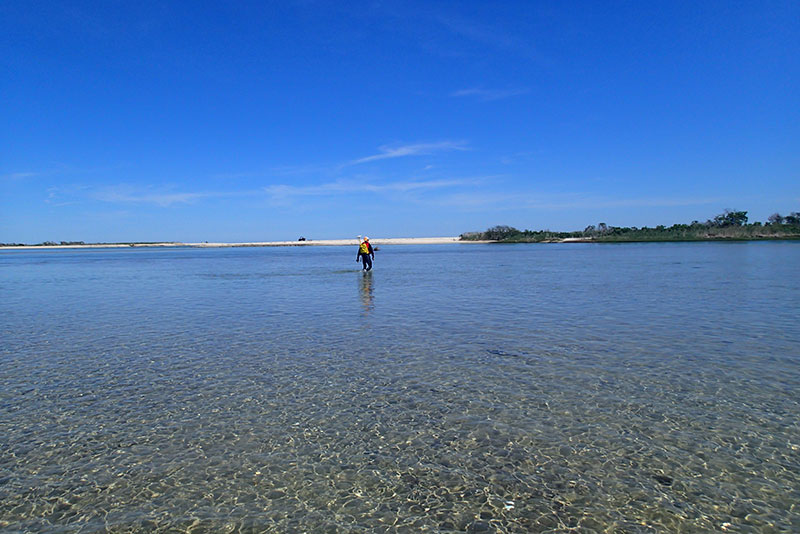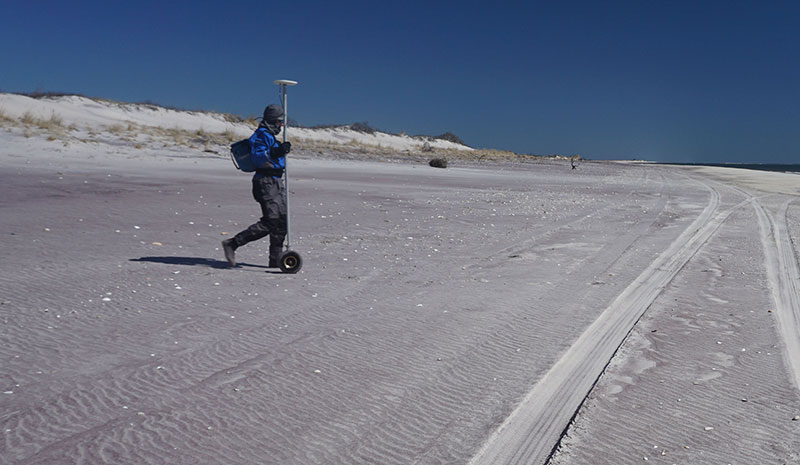Data Series 1034
| Data AcquisitionNavigationHorizontal and vertical positioning of each vessel and backpack were determined using a base-rover configuration. Data were recorded at 10 hertz (Hz) using Ashtech ProFlex™ 500 Global Navigation Satellite System (GNSS) receivers with Thales Choke Ring antennas. Three base stations were occupied during the surveys: (1) a National Geodetic Survey (NGS) benchmark west of the wilderness breach (U374; Permanent Identification Number [PID] KU0206), (2) a National Park Service benchmark near the town of Robins Rest, N. Y. (REST, see Henderson and others, 2015), and (3) a USGS benchmark set up near the National Park Service Wilderness Visitor Center (VC, see Brownell and others, 2015). The base station at benchmark U374 collected data continuously on each survey day and was equipped with an Inmarsat Broadband Global Area Network (BGAN) satellite uplink system for remote monitoring of the base station. The station consisted of an Ashtech Proflex 500 GNSS receiver and an Ashtech Choke Ring antenna with a vertical offset of 1.24 m. The base station at benchmark VC was occupied with an Ashtech Proflex 500 with Ashtech Choke Ring antenna with a vertical offset of 2 m and was used as a backup system in the event that the system at benchmark U374 failed. The base station at benchmark REST was only assembled during the Fire Island Inlet survey and was occupied with an Ashtech Proflex 500 with Ashtech Choke Ring antenna with a vertical offset of 1.5 m. GPS data acquired by the PWCs, backpack, wheel-mount, and the REST and VC base stations were downloaded at the end of each survey day. A small segment of the U374 data was downloaded via the BGAN network nightly to ensure the system was operating properly; the full dataset was collected when access to the site permitted. Simultaneous collection of base and rover positions allowed for differential post-processing of the data. Single-Beam SoundingsNearshore bathymetry was measured using single-beam sonar systems and GPS receivers mounted on two PWCs (fig. 5). The PWCs used were a 2010 (PWC1) and 2013 (PWC2) Yamaha VX Deluxe. Each PWC was fitted with a single-beam transducer mounted below the waterline off the starboard stern beneath the GPS antenna (table 1). A waterproof Pelican™ case attached on the stern of each PWC contained a Cappuccino personal computer (PC), Teledyne Odom Hydrographic Echotrac CV100 digital echo sounder, and an Ashtech Proflex 800 GNSS (fig. 9). The system was powered by a marine battery located in the front storage compartment of the PWC, and the user interface included a waterproof display, keyboard, and mouse.
Table 1. Elevation difference between transducer and GPS antenna
 Figure 9. PWC instrument configuration (left) and Pelican Case hardware configuration (right). [Click image to enlarge] The sonar system utilized a 200 kilohertz (kHz) single-beam transducer and recorded digitized raw acoustic backscatter returns with a vertical resolution of 0.01 m +/–0.1 percent depth. A four-degree transducer was used on PWC1 while a wider beam nine-degree transducer was used on PWC2. Different transducers were used because of equipment failure in the field. HYPACK, a navigation and data acquisition software, merges soundings into a raw data file (.raw), containing the estimated seafloor depth, and a sounding file (.bin), containing the return intensity in real time. PWC operators followed predefined track lines using a HYPACK map interface which displays vessel position in real time. Within the wilderness breach, planned lines were followed when possible; however, the abundant shoals required operators to follow deeper tidal channels as opposed to planned lines. Additional soundings were collected within the main breach channel to obtain high-resolution control over channel boundaries where large depth changes occurred. Operators did not follow planned lines for Fire Island Inlet or Narrow Bay but covered as much area as possible within the allotted time. Backpack GPSElevation data were collected using an Ashtech Z-Xtreme GPS receiver mounted in a SECO backpack with Ashtech Marine antennas attached to a pole extending above the head of the surveyor. The elevation of the antenna relative to the ground was measured for each surveyor in a walking stride position (varying between 1.67 to 1.7 m). The surveyors did not follow a pre-defined path but collected data over as much of the subaerial and shallow shoals and subaerial beach (foreshore and backshore) as possible during low tide (fig. 10).  Figure 10. Shallow flood shoals and channels elevation data being collected using a backpack GPS system within the wilderness breach. [Click image to enlarge] Wheel-Mounted GPSElevation data along the mean high water (MHW) shoreline and subaerial beach were collected using an Ashtech Z-Xtreme GPS receiver with Ashtech Marine antennas attached to a fixed-height wheel mount with an antenna height of 2 m. The surveyors followed predefined transects along the subaerial beach in line with offshore PWC transects and collected additional data approximating the mean high water shoreline and topography of the spit along the western shore of the wilderness breach (fig. 11).  Figure 11. Beach and shoreline elevation data being collected using a fixed-height wheel mounted GPS system near the wilderness breach. [Click image to enlarge] Sound VelocityAccurate sound velocity measurements are necessary to correct sounding errors due to density gradients through the water column. Water column sound velocity measurements were collected periodically throughout the survey using a SonTek CastAway conductivity, temperature, and depth (CTD) instrument. Data were processed using SonTek CastAway CTD software version 1.5. |